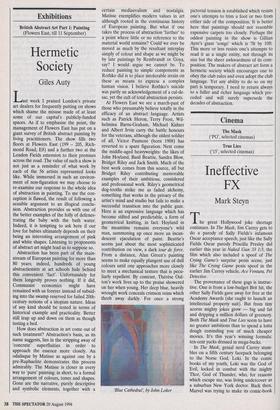Exhibitions
British Abstract Art Part 1: Painting (Flowers East, till 11 September)
Hermetic Society
Giles Auty
Last week I praised London's private art dealers for frequently putting on shows which shame the misuse made of at least some of our capital's publicly-funded spaces. As if to emphasise the point, the management of Flowers East has put on a giant survey of British abstract painting by living practitioners. The show fills two floors at Flowers East (199 – 205, Rich- mond Road, E8) and a further two at the London Fields extension to their premises across the road. The value of such a show is not just as a reminder of what work by each of the 56 artists represented looks like. While immersed in such an environ- ment of non-figuration we may choose to re-examine our response to the whole idea of abstraction in painting. To me the con- ception is flawed, the result of following a sensible argument to an illogical conclu- sion. Abstraction provides us with one of the better examples of the folly of defenes- trating the baby with the bath water. Indeed, it is tempting to ask here if our love for babies ultimately depends on their being an interesting arrangement of pink and white shapes. Listening to proponents of abstract art might lead us to suppose so.
Abstraction has been part of the main- stream of European painting for more than 80 years; indeed, hundreds of young abstractionists at art schools hide behind this convenient 'fact'. Unfortunately for them longevity proves nothing. If it did, Communist economics might have remained with us forever instead of subsid- ing into the swamp reserved for failed 20th- century notions of a utopian nature. Ideas of any kind should be tested in terms of historical example and practicality. Better still leap up and down on them as though testing a bed.
How does abstraction in art come out of such treatment? Abstraction's basis, as its name suggests, lies in the stripping away of `concrete' superfluities in order to approach the essence more closely. An odalisque by Matisse as against one by a pre-Raphaelite demonstrates this process admirably. The Matisse is closer in every way to 'pure' painting: in short, to a formal arrangement of colours, tones and shapes. Gone are the narrative, purely descriptive and symbolic elements, together with a certain mediaevalism and nostalgia. Matisse exemplifies modern values in art although rooted in the continuous history of European painting. But what if one takes the process of abstraction 'further' to a point where little or no reference to the material world remains? Could we ever be moved as much by the resultant interplay simply of colour and shape as we might be by late paintings by Rembrandt or Goya, say? I would argue we cannot be. To reduce painting to simple components as Rothko did is to place intolerable strain on these as means to express a complex human vision. I believe Rothko's suicide was partly an acknowledgement of a cul-de- sac, yet the cult of total abstraction persists.
At Flowers East we see a march-past of those who presumably believe totally in the efficacy of an abstract language. Artists such as Patrick Heron, Terry Frost, Wil- helmina Barns-Graham, Michael Kidner and Albert Irvin carry the battle honours for the veterans, although the oldest soldier of all, Victor Pasmore (born 1908) has reverted to a spare figuration. Next come the middle-aged heavyweights: the likes of John Hoyland, Basil Beattie, Sandra Blow, Bridget Riley and Jack Smith. Much of the best work comes from this source, all but Bridget Riley contributing memorable examples of their ambitious, considered and professional work. Riley's geometrical dog-tooths strike me as failed alchemy, something that works in the privacy of the artist's mind and studio but fails to make a successful transition into the public gaze. Here is an expressive language which has become stilted and predictable, a form of geometrical knitting, in fact. Hoyland in the meantime remains everyone's wild man, summoning up once more an incan- descent ejaculation of paint. Beattie's seems just about the most sophisticated contribution on view, a dark tour de force. From a distance, Alan Green's painting seems to make equally plangent use of dull colours until one approaches more closely to meet a mechanical texture that is pecu- liarly repellent. By contrast, Therese Oul- ton's work lives up to the praise showered on her when young. Her deep blue, heavily wrought work conceals crimson veins which throb away darkly. For once a strong Blue Cathedral, by John Loker pictorial tension is established which resists one's attempts to trim a foot or two from either side of the composition. It is better here that paintings should not resemble expensive carpets too closely. Perhaps the oddest painting in the show is Gillian Ayre's giant `songe' which is 7ft by 10ft. This more or less resists one's attempts to read it as a single entity, not through its size but the sheer awkwardness of its com- position. The makers of abstract art form a hermetic society which encourages one to obey the club rules and even adopt the club language. Yet any ability to do so on my part is temporary. I need to return always to a fuller and richer language which pre- ceded and will surely supersede the decades of abstraction.


















































 Previous page
Previous page